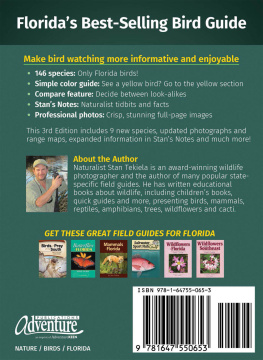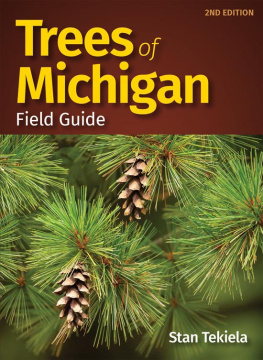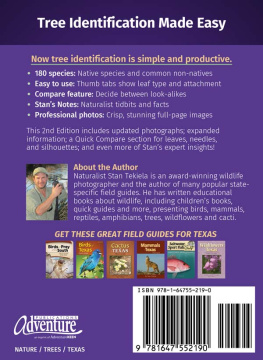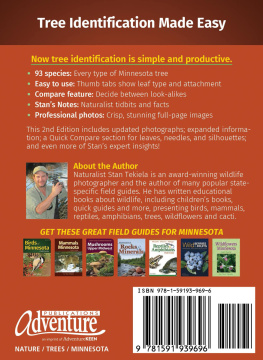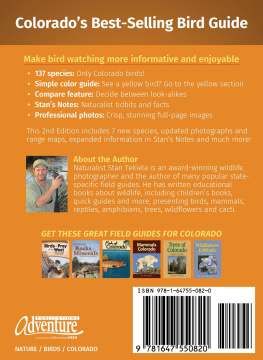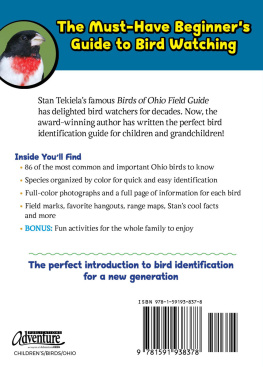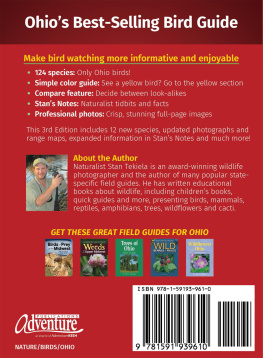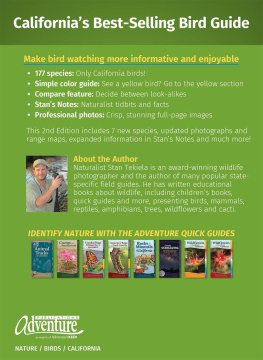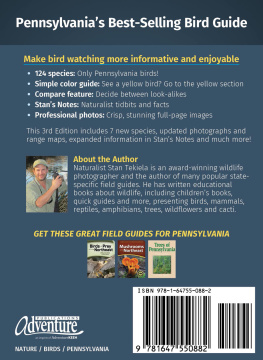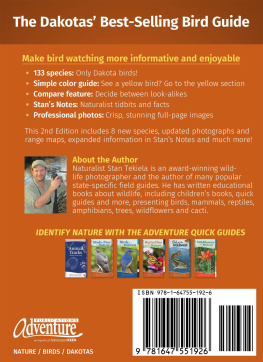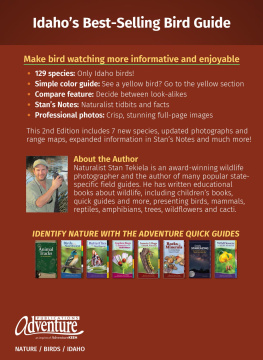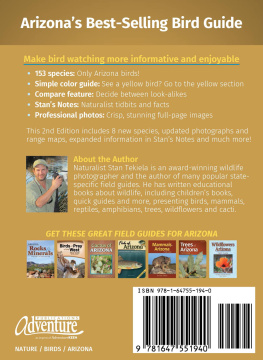Stan Tekiela - Birds of Florida Field Guide
Here you can read online Stan Tekiela - Birds of Florida Field Guide full text of the book (entire story) in english for free. Download pdf and epub, get meaning, cover and reviews about this ebook. year: 2020, publisher: Adventure Publications, genre: Home and family. Description of the work, (preface) as well as reviews are available. Best literature library LitArk.com created for fans of good reading and offers a wide selection of genres:
Romance novel
Science fiction
Adventure
Detective
Science
History
Home and family
Prose
Art
Politics
Computer
Non-fiction
Religion
Business
Children
Humor
Choose a favorite category and find really read worthwhile books. Enjoy immersion in the world of imagination, feel the emotions of the characters or learn something new for yourself, make an fascinating discovery.
- Book:Birds of Florida Field Guide
- Author:
- Publisher:Adventure Publications
- Genre:
- Year:2020
- Rating:5 / 5
- Favourites:Add to favourites
- Your mark:
- 100
- 1
- 2
- 3
- 4
- 5
Birds of Florida Field Guide: summary, description and annotation
We offer to read an annotation, description, summary or preface (depends on what the author of the book "Birds of Florida Field Guide" wrote himself). If you haven't found the necessary information about the book — write in the comments, we will try to find it.
Birds of Florida Field Guide — read online for free the complete book (whole text) full work
Below is the text of the book, divided by pages. System saving the place of the last page read, allows you to conveniently read the book "Birds of Florida Field Guide" online for free, without having to search again every time where you left off. Put a bookmark, and you can go to the page where you finished reading at any time.
Font size:
Interval:
Bookmark:



Edited by Sandy Livoti and Dan Downing
Cover, book design and illustrations by Jonathan Norberg
Range maps produced by Anthony Hertzel
Cover photo: Painted Bunting by Stan Tekiela
All photos by Stan Tekiela except (female) by Jim Zipp
To the best of the publishers knowledge, all photos were of live birds. Some were photographed in a controlled condition.
10 9 8 7 6 5 4 3 2 1
Birds of Florida Field Guide
First Edition 2001, Second Edition 2004
Third Edition 2020
Copyright 2001, 2004 and 2020 by Stan Tekiela
Published by Adventure Publications
An imprint of AdventureKEEN
330 Garfield Street South
Cambridge, Minnesota 55008
(800) 678-7006
www.adventurepublications.net
All rights reserved
Printed in China
ISBN 978-1-64755-065-3 (pbk.); ISBN 978-1-64755-066-0 (ebook)
Dedication
To my wife, Katherine, and daughter, Abigail, with all my love.
Acknowledgments
Special thanks to the National Wildlife Refuge System, which stewards the land that is critical to many bird species. Thanks also to Bill Pranty, Audubon of Florida, and Wes Biggs, President of Florida Nature Tours, for reviewing the range maps.
TABLE OF CONTENTS
Sample Pages
The Birds
WHATS NEW?
It is hard to believe that its been more than 15 years since the debut of Birds of Florida Field Guide. This critically acclaimed field guide has helped countless people identify and enjoy the birds that we love. Now, in this expanded third edition, Birds of Florida Field Guide has many new and exciting changes and a fresh look, while retaining the same familiar, easy-to-use format.
To help you identify even more birds in Florida, I have added 9 new species and more than 150 new color photographs. All of the range maps have been meticulously reviewed, and many updates have been made to reflect the ever-changing movements of the birds.
Everyones favorite section, Stans Notes, has been expanded to include even more natural history information. Compare sections have been updated to help ensure that you correctly identify your bird, and additional feeder information has been added to help with bird feeding. I hope you will enjoy this great new edition as you continue to learn about and appreciate our Florida birds!

WHY WATCH BIRDS IN FLORIDA?
Millions of people have discovered bird feeding. Its a simple and enjoyable way to bring the beauty of birds closer to your home. Watching the birds at your feeder and listening to them often leads to a lifetime pursuit of bird identification. The Birds of Florida Field Guide is for those who want to identify the common birds of Florida.
There are over 1,100 species of birds found in North America. In Florida alone there have been more than 500 different kinds of birds recorded through the years. That is an impressive amount of birds for a single state! These bird sightings were diligently recorded by hundreds of bird watchers and became part of the official state record. From these valuable records, I have chosen 146 of the most common and easily seen birds of Florida to include in this field guide.
Bird watching, often called birding, is one of the most popular activities in America. Its outstanding appeal in Florida is due, in part, to an unusually rich and abundant birdlife. Why are there so many birds in this state? One reason is water, both saltwater and fresh. Peninsular Florida is surrounded by water and has 1,350 miles (2,175 km) of coastline. Its home to many ocean-loving birds such as the colony-nesting Royal Tern and surf-running Sanderling. In addition to the coast, Florida has thousands of sizable lakes such as Lake Okeechobeethe eighth largest lake in the U.S.thousands of freshwater and saltwater marshes, not to mention four major rivers. All of this water attracts millions of birds such as the Tricolored Heron and Roseate Spoonbill.
Climate is another reason why Florida has so many birds. The northern part of Florida is classified as humid subtropical, while southern Florida is considered tropical wet, more typical of Central America. The relatively warm climate affords birds extra time to raise more than one brood per season, or to feed unimpeded during severe winters elsewhere.
Southern Florida not only attracts people to its warm winter climate, it is also a winter home to hundreds of migratory bird species. From tiny birds, such as the Palm and Black-and-white Warblers, to the Ruddy Turnstone, an ornately colored shorebird that nests in coastal Alaska, millions of birds pack into southern Florida each winter to feed in the states nutrient-rich waters and fertile forests.
While water and weather are good reasons for a vast abundance of birds in Florida, keep in mind the great size of the state. Florida is the twenty-second largest state, covering approximately 65,755 square miles (170,300 sq. km), about 50 percent of which is covered with forest. Floridas forests are home to such birds as the Chuck-wills-widow, whose calls throughout the night can be heard each spring and summer.
Florida is one of the best places in North America to see a wide array of birds. Whether witnessing a nesting colony of herons and egrets in the Everglades or welcoming back the wintering shorebirds, bird watchers enjoy variety and excitement in Florida as each season turns to the next.
OBSERVE WITH A STRATEGY; TIPS FOR IDENTIFYING BIRDS
Identifying birds isnt as difficult as you might think. By simply following a few basic strategies, you can increase your chances of successfully identifying most birds that you see. One of the first and easiest things to do when you see a new bird is to note its color. This field guide is organized by color, so simply turn to the right color section to find it.
Next, note the size of the bird. A strategy to quickly estimate size is to compare different birds. Pick a small, a medium and a large bird. Select an American Robin as the medium bird. Measured from bill tip to tail tip, a robin is 10 inches (25 cm). Now select two other birds, one smaller and one larger. Good choices are a House Sparrow, at about 6 inches (15 cm), and an American Crow, around 18 inches (45 cm). When you see a species you dont know, you can now quickly ask yourself, Is it larger than a sparrow but smaller than a robin? When you look in your field guide to identify your bird, you would check the species that are roughly 610 inches (1525 cm). This will help to narrow your choices.
Next, note the size, shape and color of the bill. Is it long or short, thick or thin, pointed or blunt, curved or straight? Seed-eating birds, such as Northern Cardinals, have bills that are thick and strong enough to crack even the toughest seeds. Birds that sip nectar, such as Ruby-throated Hummingbirds, need long, thin bills to reach deep into flowers. Hawks and owls tear their prey with very sharp, curving bills. Sometimes, just noting the bill shape can help you decide whether the bird is a woodpecker, finch, blackbird or bird of prey.
Next pageFont size:
Interval:
Bookmark:
Similar books «Birds of Florida Field Guide»
Look at similar books to Birds of Florida Field Guide. We have selected literature similar in name and meaning in the hope of providing readers with more options to find new, interesting, not yet read works.
Discussion, reviews of the book Birds of Florida Field Guide and just readers' own opinions. Leave your comments, write what you think about the work, its meaning or the main characters. Specify what exactly you liked and what you didn't like, and why you think so.

